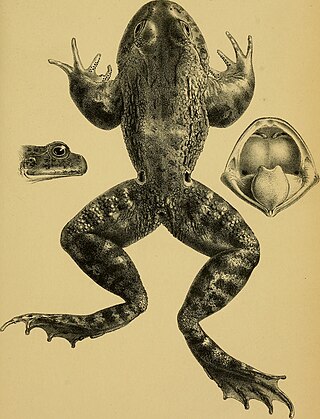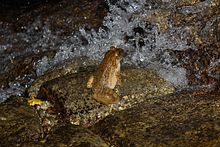
Limnonectes is a genus of fork-tongued frogs of about 75 known species, but new ones are still being described occasionally. They are collectively known as fanged frogs because they tend to have unusually large teeth, which are small or absent in other frogs.

Limnonectes fujianensis is a species of frog in the family Dicroglossidae. It is most closely related to, and formerly confused with Limnonectes kuhlii. Its name refers to the type locality in Fujian province of China. It is also found in Hunan, Zhejiang, and Jiangxi in China as well as in Taiwan. and other sources give a somewhat broader distribution.
Quasipaa yei, or Ye's spiny-vented frog, is a species of frog in the family Dicroglossidae. It is endemic to China where it is known from the Dabie Mountains that straddle the border between Hubei, Henan, and Anhui provinces. Its type locality is in Shengcheng County in Jiyuan City, Henan. Its natural habitats are temperate rivers with surrounding forests. It is potentially threatened by habitat loss.

The Chinese edible frog, East Asian bullfrog, or Taiwanese frog is a species of frog in the family Dicroglossidae. It is found in Cambodia, China, Hong Kong, Laos, Macau, Malaysia, Myanmar, the Philippines, Taiwan, Thailand, and Vietnam. Its natural habitats are freshwater marshes, intermittent freshwater marshes, arable land, pasture land, rural gardens, urban areas, ponds, aquaculture ponds, open excavations, irrigated land, seasonally flooded agricultural land, and canals and ditches. They breed in spring to early summer.
Quasipaa boulengeri is a species of frog in the family Dicroglossidae. It is known under many common names, including Boulenger's spiny frog, spiny-bellied frog, and Boulenger's paa frog. It is found in southern and southwestern China and northern Vietnam. It is a very common species that has declined. It is collected for human consumption, and it is also threatened by habitat loss. Its natural habitats are hill streams and ponds.

Quasipaa exilispinosa is a species of frog in the family Dicroglossidae. It is known under many common names, including Hong Kong spiny frog, common spiny frog, lesser spiny frog, little spiny frog, and Hong Kong paa frog. It has a patchy distribution in southern China including Hong Kong. Its natural habitats are subtropical hill streams in forests or shrublands, and sometimes also seepages, stream-fed marshes, and forests. It is threatened by over-collecting for human consumption and by habitat loss.
Quasipaa fasciculispina is a species of frog in the family Dicroglossidae. It is known under many common names: spiny-breasted giant frog, spiny-breasted frog, spine-glanded mountain frog, and Thai paa frog. It is found in the Cardamom Mountains in southwestern Cambodia and eastern Thailand. It is found in on near fast-flowing mountain streams in tropical evergreen forests. It is threatened by collecting for human consumption and by habitat loss.

Nanorana feae is a species of frog in the family Dicroglossidae. It is found in Yunnan, China, and the Kachin Hills in Myanmar. The specific name feae honors Leonardo Fea, an Italian explorer, zoologist, and naturalist. This little-known species probably inhabits hill streams in forested areas.
Quasipaa jiulongensis is a species of frog in the family Dicroglossidae. It is endemic to eastern China and only known from the mountains of southwestern Zhejiang and adjacent Fujian above 800 m (2,600 ft) elevation. Its natural habitats are hill streams. It is threatened by habitat loss due to both logging and infrastructure development as well as by collection for food.
Nanorana polunini is a species of frog in the family Dicroglossidae. It is found in Nyalam County in southern Tibet (China), Nepal, and possibly Kashmir (India). It is a common species in Nepal but rare in China. It lives in stream habitats in montane forest.
Quasipaa robertingeri is a species of frog in the family Dicroglossidae. It is endemic to Southwest China and is known from southeastern Sichuan, Chonqing, and northern Guizhou. It is named in honor of Robert F. Inger, an American herpetologist and ichthyologist. Common name Hejiang spiny frog has been proposed for it.
Quasipaa shini is a species of frog in the family Dicroglossidae. It is endemic to southern central China. Its natural habitats are rivers in subtropical moist lowland forests and montane forest at elevations of 510–1,500 m (1,670–4,920 ft) asl. It is threatened by over-collecting for human consumption and by habitat loss.
Nanorana yunnanensis, commonly known as Yunnan paa frog, Yunnan spiny frog, Bourret's paa frog or Bourret's frog, is a species of frog in the family Dicroglossidae. It is found in southwestern China, Vietnam, Myanmar, northern Thailand, and likely in the intervening Laos. Its natural habitats are small and large streams in montane forests, scrub vegetation and grasslands, and it has also been found in ditches. It is threatened primarily by collection for human consumption, but also by habitat loss caused by agricultural development and infrastructure development.

Hylarana guentheri is a species of frog in the family Ranidae. It was formerly placed in the genus Rana. It is found in China, Hong Kong, Macau, Taiwan, Vietnam, and possibly Cambodia and Laos. An introduced population is found on Guam. An alternate common name is Günther's Amoy frog, and the honorific is often spelled "Guenther's".

Quasipaa is a genus of frogs in the family Dicroglossidae. The genus has no established common name, but many individual species are referred to as spiny frogs. They occur in East and Southeast Asia, from Thailand and Cambodia to southern and eastern China.
Hong Kong frog may refer to:
Limnonectes bannaensis is a species of frogs in the family Dicroglossidae. It is found in southern China, Laos, Thailand and Vietnam.
Quasipaa acanthophora is a species of frog in the family Dicroglossidae. It is endemic to northern Vietnam and know from two locations, its type locality Mau Son in the Lang Son Province, and the Tay Yen Tu Nature Reserve in the Bac Giang Province. It is a sibling species of Quasipaa spinosa.
Brachytarsophrys orientalis, the Oriental short-legged toad, is a species of litter frog in the family Megophryidae. It is native to Jiangxi and Fujian in southeastern China. It is the easternmost species within the genus Brachytarsophrys, hence the specific name orientalis.









